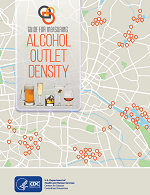Research in Action
Tools to support states and communities in the prevention of excessive drinking
Alcohol Screening and Brief Intervention for People Who Consume Alcohol and Use Opioids
Because excessive drinkers who use opioid pain relievers are at greater risk of overdose and death, CDC created this fact sheet to introduce health departments and health care providers to alcohol screening and brief intervention and to discuss its usefulness for helping excessive drinkers drink less when they have been prescribed an opioid pain reliever or stop drinking altogether while using these medications.
CDC Guide for Measuring Alcohol Outlet Density Cdc-pdf[PDF – 11 MB]
CDC developed the Guide for Measuring Alcohol Outlet Density to help public health practitioners measure alcohol outlet density—which is a key risk factor for excessive drinking—at state and local levels. This Guide discusses the importance of measuring alcohol outlet density and different approaches for doing so, along with their pros and cons.
Community Anti-Drug Coalitions of America (CADCA) StrategizersExternal
CDC supported the development of Strategizers—CADCA’s technical assistance manuals—on regulating alcohol outlet density and reducing alcohol-related harms through commercial host liability.
Pricing strategies for alcohol products is one of 14 evidence-based, communitywide interventions included in the CDC Health Impact in 5 Years (HI-5) initiative. This initiative highlights nonclinical, communitywide approaches that have evidence reporting (1) positive health impacts, (2) results within 5 years, and (3) cost effectiveness and/or cost savings over the lifetime of the population or earlier.
Preventing Cancer by Reducing Excessive Alcohol Use
CDC’s Policies and Practices for Cancer Prevention policy brief on preventing cancer by reducing excessive alcohol use includes information on cancer risks linked to alcohol use, what works to reduce excessive alcohol use, and what comprehensive cancer control programs can do to reduce the risk of alcohol-attributable cancers.
The prevention of alcohol-related harms is one of 10 public health problems and concerns included in the 2013 and 2015 CDC Prevention Status Reports (PSRs). The PSRs highlight—for all 50 states and the District of Columbia—the status of public health policies and practices designed to address important public health problems and concerns.
Binge drinking, alcohol poisoning deaths, and alcohol screening and counseling are among the topics that have been featured in CDC’s monthly Vital Signs report. These reports include an MMWR Early Release, a graphic fact sheet and website, a media release, and social media tools. Most of the materials are available in English and Spanish.
What Works: Preventing Excessive Alcohol ConsumptionCdc-pdfExternal [PDF-992 KB]
This Community Guide brochure summarizes the strategies the Community Preventive Services Task Force recommends for reducing excessive alcohol use, based on systematic reviews of the evidence.
